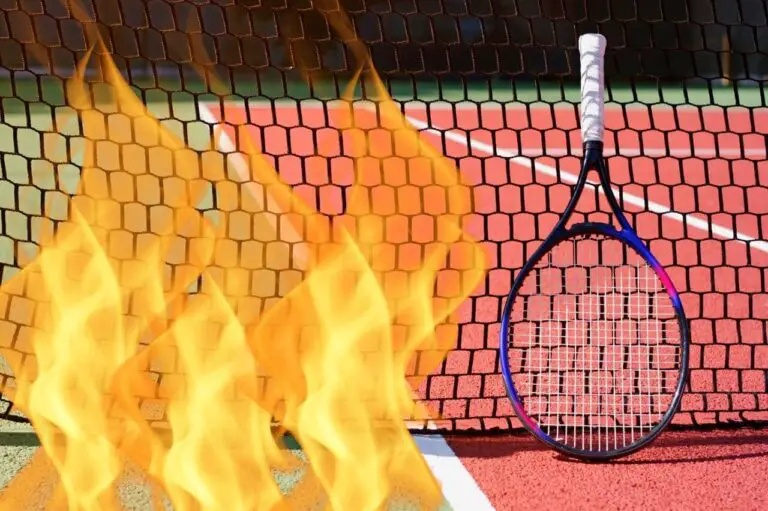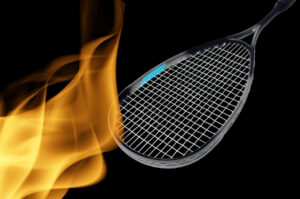Do you know why is graphite used in tennis racket handles?
It’s a common material because it has some unique properties that make it perfect for this application.
In this guide, we will discuss why graphite is used in tennis racket handles and what benefits it provides.
We’ll also take a look at some of the other materials that could be used in this application and compare them to graphite.
Keep reading to learn more!
Why is graphite used in tennis racket handles?
The answer is simple: Graphite is very strong for its weight.
It perfectly balances strength, lightness, durability, stiffness, vibration absorption, and flexibility.
Graphite also has a unique feel that many players appreciate when they’re playing with their racquets.
It helps them to control the ball better and gives them a better sense of touch when handling the racquet.
These factors all combine to make graphite a popular choice for tennis racket handles.

What are some other materials that could be used in the tennis racket handle?
Manufacturers today produce tennis rackets from different types of metals such as aluminum, steel, titanium, fiberglass, and magnesium.
Some racks are also made of metal matrix composites and ceramic fibers for added strength.
These materials can provide a different feel and performance than graphite, but they also tend to be more expensive and less flexible.
In addition, some of these materials are heavier than graphite and may not be suitable for players who prefer a lighter racquet.
Ultimately, the choice of material for a tennis racket handle is up to the individual player.
Is there any disadvantage to using graphite in a tennis racket?
One downside of graphite is that it is composed of brittle fibers.
If a player uses it too much, he can cause damage that might reduce its effectiveness as a tool for the game.
In addition, graphite may not be suitable for players who prefer a heavier racquet.
How long does a graphite tennis racket last?
A graphite tennis racket can last anywhere from one year to ten years depending on how often it is used.
The average lifespan of a racket for competitive, professional athletes is only one year before it starts to lose stiffness.
However, If you’re a club player who hits the ball softly and takes care of their rackets, they can last for a decade or more without any issues.
Keep in mind that With time, the frame will become less stiff and “soft.” If this occurs, you’ll have weaker power and control.
How is graphene used in tennis rackets?
By strategically placing Graphene in the shaft of the racquet, Head has been able to redistribute weight to areas of the frame that need it most, such as the tip of the frame and the grip.
By adding weight to key areas of the racket, you can create more kinetic energy when hitting the ball, meaning you’ll hit it harder without having to put in as much effort.
What is the difference between Titanium racquets and graphite racquets?
The main difference between titanium and graphite racquets is weight.
Titanium racquets are lighter, making them easier to swing.
Graphite racquets are heavier, providing more power for shots.
Both materials have their advantages in terms of strength and durability as well.
What are cheap tennis racquets made of?
Cheap tennis racquets are often made of aluminum, which is an inexpensive and light material.
Aluminum is a great option for recreational players who want an affordable racket but don’t need the same level of performance as professional players.
The downside to aluminum rackets is that they can be less durable and may flex more than other materials.
They may also not provide the same level of control or feel as more expensive rackets made from graphite, titanium, or metal matrix composites.
Still, for the price and performance you get, aluminum racquets are a great option for casual players who just want to have fun on the court!
Where can you purchase a new graphite tennis racket?
You can purchase new graphite tennis rackets from a variety of sources, including sporting goods stores, Amazon, online retailers, and specialty shops.
When purchasing a racket, be sure to consider factors such as price, weight, balance, grip size, and type of strings used in the frame.
It’s also important to take into account any special features the racket may have, such as vibration-dampening technology or a larger sweet spot.
By taking all of these factors into account, you can ensure that you’re purchasing a racquet that will suit your playing style and provide the best performance possible.
You can also purchase a new graphite tennis racket by clicking here!
In conclusion:
Graphite is a popular and effective choice for tennis racket handles due to its light weight, strength, and power.
However, it is important to keep in mind that graphite may not be suitable for players who prefer a heavier racquet.
Graphene technology has enabled manufacturers to redistribute weight strategically within the racket frame, making them more powerful and easier to use.
Additionally, cheaper alternatives such as aluminum rackets can provide adequate performance for recreational players.
No matter which type of racket you decide to purchase, make sure to factor in all the necessary criteria so that you end up with a perfect product for your game. Good luck!
I hope you enjoyed this comprehensive guide.
Stay tuned for more posts about interesting topics in the world of tennis!
If you have any further questions, please feel free to comment below, and I will be happy to answer you! 🙂
And be sure to check out my other blog posts for more informative guides.
Thanks for reading, and have a nice day! 🙂








